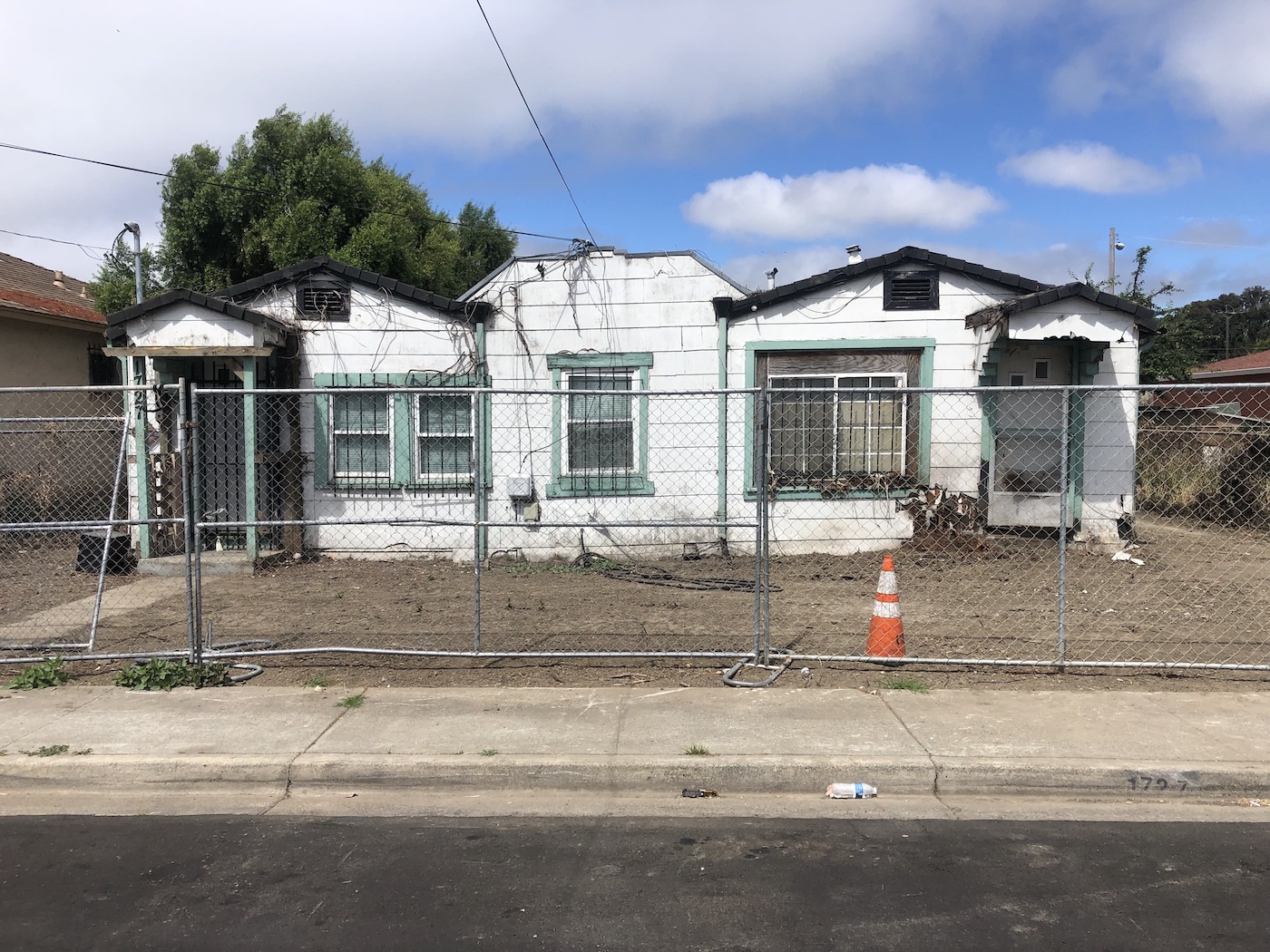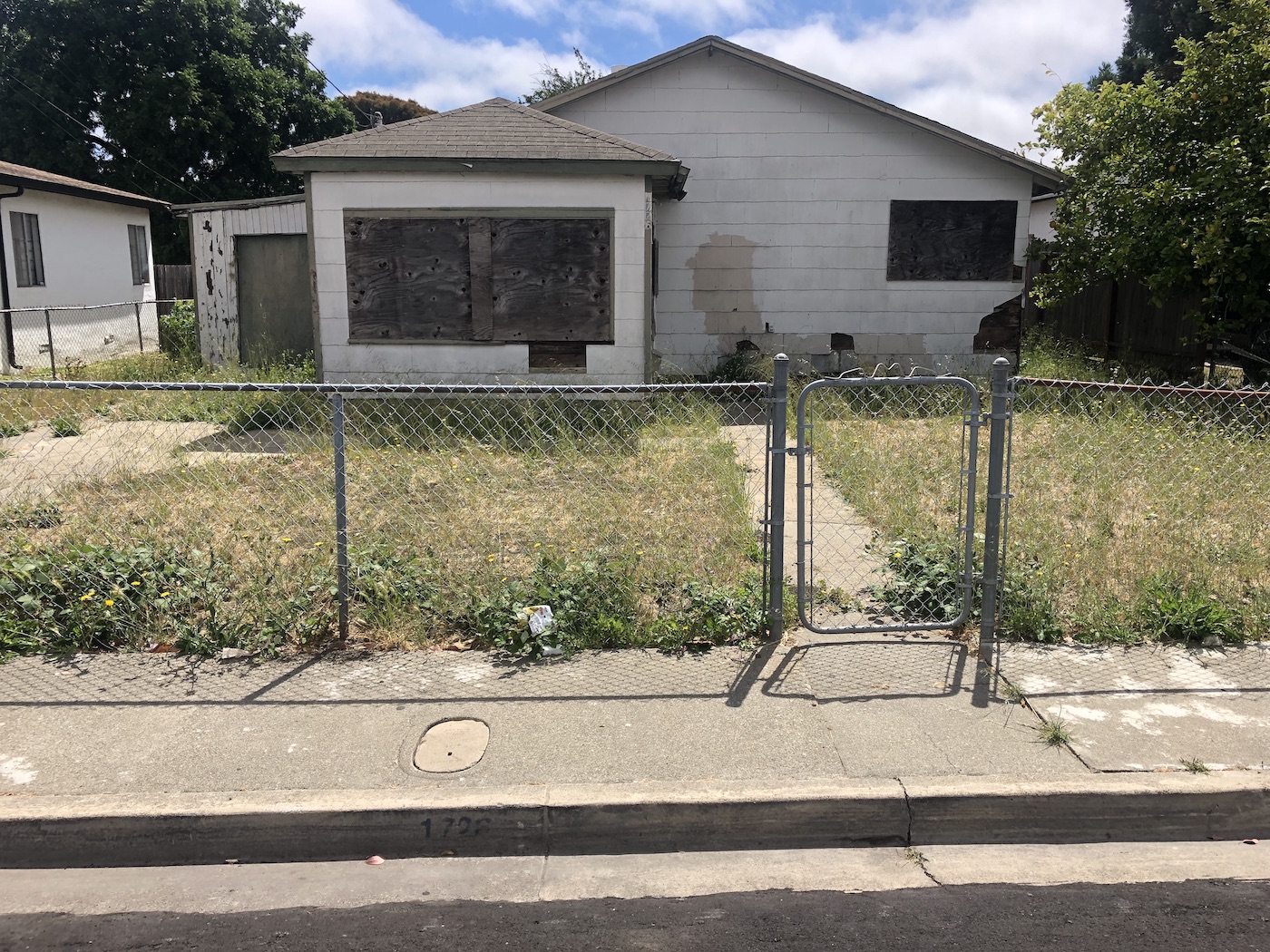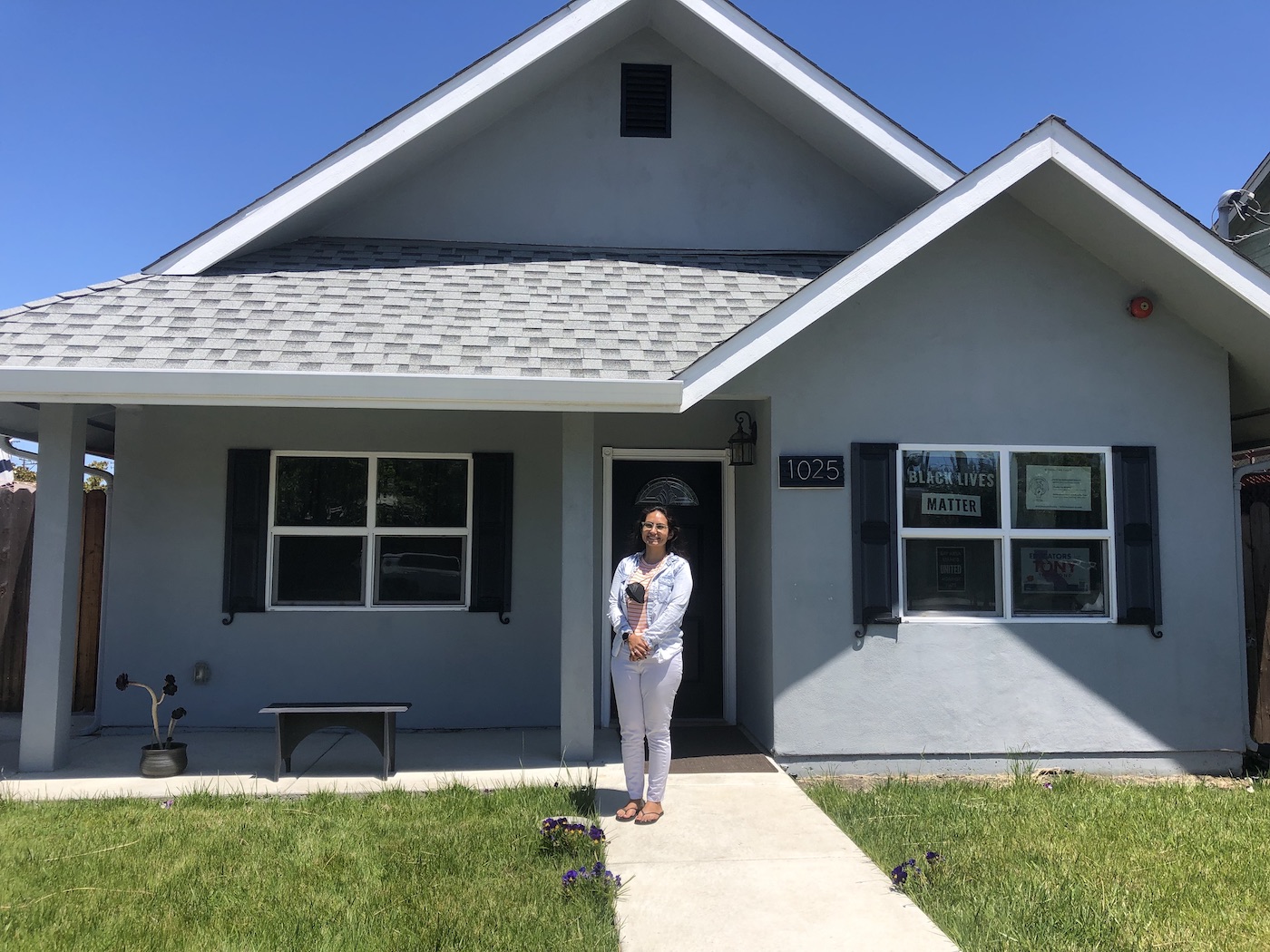Standing outside the sagging house on 2nd Street in North Richmond, California, it was hard to imagine it as the future site of a pioneering clean energy project. The building’s rotting white siding seemed to sink into the dirt yard with no real foundation. Chunks of it were crumbling to the ground. As we walked around to the back, Jim Becker, my tour guide, pointed to a plastic pipe sticking out of the wall.
“Here, the sewage was just flushing out onto the dirt,” he said. “It was just shooting all the poop into the garden.”
But Becker was excited. He was showing me this house as a sort of “before” picture. Soon, workers will take the building down to its studs and reconstruct the walls and roof. Then it will get a full menu of clean energy offerings: energy-efficient lighting, an electric vehicle charger, an electric stove, electric heat pumps for heating and air conditioning, an internet-connected “smart thermostat.” Solar panels will line the roof, and a backup battery will allow future residents to keep the lights on and the refrigerator running during a power outage.
When the retrofit is done, the house will not be listed publicly on the cutthroat Bay Area real estate market. Instead, it will be shown to a select group of Richmond locals, mostly from low and middle-income backgrounds, who are looking to buy their first home.

Becker is the CEO of a nonprofit called RCF Connects, formerly known as the Richmond Community Foundation. The renovations are the extension of a successful program Becker has been running for years to revitalize communities in and around Richmond by restoring abandoned homes and facilitating first-time home ownership among the city’s Black and brown residents. But now, working with new partners and a grant from the California Energy Commission, RCF is trying something a little different.
When a buyer moves into the house on 2nd Street, they’ll not only enjoy low energy bills and access to electricity during an outage — they’ll also be helping to relieve California’s congested power grid, and even be able to make money doing it. That’s because the house will be part of a new “virtual power plant”.
Virtual power plants, or VPPs, are an innovative way to bring more flexibility and stability to the electric grid as it becomes increasingly jeopardized by fires, heatwaves, and growing demand.
Traditional power plants, like a natural gas plant, burn fuel to generate electricity. A single facility can generate a set amount of power — say, 10 megawatts — whenever it’s needed by consumers.
A VPP, on the other hand, might be made up of hundreds of devices spread across any number of locations that, when taken together, can provide that same 10 megawatts. But the VPP might provide that resource not just by generating electricity, but also by dispatching power that was stored in a battery, or by reducing demand.
For example, a VPP might include rooftop solar panels on a bunch of residential and commercial buildings that send electricity to the grid. It might also include the ability to lower the thermostat by a couple of degrees in those buildings for a few hours, or to manage what time of day the occupants charge their electric vehicles or heat up water.

Today, many customers already get credits on their electric utility bills for energy generated by their solar panels or for participating in so-called “demand response” programs that reward behavioral changes. A VPP bundles those services together and sells them as a package.
“It’s not a power plant in the way that we’ve historically looked at them,” said Andy Bennett, the CEO of mPrest, the company that’s building the software to manage Richmond’s virtual power plant. “But you’ve created that same virtual capacity on the grid.”
That capacity can be sold on the power market like any other source of electricity.
And in exchange for tolerating temperature adjustments, or allowing the VPP operator to draw power from their home battery systems, residents stand to see a more stable grid, lower bills, and a share of the proceeds from the sale.
With all-electric homes, they’ll also be helping to cut greenhouse gas emissions and local air pollution. Neighborhoods in North Richmond rank in the 80th to 89th percentile in the state for pollution burden — largely because they abut a sprawling Chevron oil refinery, the largest on the West Coast. One-fifth of the population in North Richmond, a small unincorporated area surrounded by the city of Richmond, falls below the federal poverty line, according to 2019 census data, compared with one-seventh in Richmond proper.
RCF has completed 20 renovations since it first started its program to address blight in Richmond in 2015. In some cases, the previous owners of these homes died without making plans to transfer the property to an heir. Others fell victim to the subprime mortgage crisis. The vacant properties that pervade the city become targets for illegal dumping and habitation and cost the city thousands of dollars a year per home to manage. The sites also bring down neighboring property values and eat away at the social fabric of the city’s communities.
“We had to come up with a strategy to try to deal with that,” said Becker, “and also try to prevent gentrification.”

The strategy involves leveraging a financial tool called a social impact bond to purchase the properties and fund the renovation work. RCF worked with the city to convince a local bank to invest in a set number of projects over a set number of years.
To prevent gentrification, RCF gives priority access to the homes to participants in a financial counseling service and first-time home buyer program that it also runs. The nonprofit also has a down payment assistance program for Black first-time home buyers that offers up to $20,000, and it helps participants secure other grants that are available through the California Housing Finance Agency and other outside organizations.
Mitzi Perez was one of the beneficiaries of RCF’s programs in 2018 and now serves on the nonprofit’s board of directors. Perez was born and raised in Richmond. Her parents immigrated from Mexico when they were young, and she was the first in her family to go to college. She’s not the first in her family to buy a home — her parents, a dental assistant and construction worker, owned the house she grew up in. But after college, she became a teacher and imagined she’d probably be renting for years based on her salary. RCF enabled Perez and her husband to secure their future in Richmond much sooner, around the corner from where she grew up, no less.
“Richmond was always home to me, and I couldn’t see myself leaving it,” she told Grist. “I really want to see people who are homegrown like I am get their own home here and feel like they can continue their legacy in their community.”
Perez’ house has some of the bells and whistles that the 2nd Street house will get, like energy-efficient appliances, electric heat pumps, and even solar panels. But in 2018, RCF didn’t have the money to do much more. Only now, with a $3 million grant from the California Energy Commission for the VPP, can it install the full suite of features going in on 2nd Street.

Not all of that money will go toward RCF’s renovation projects — Becker said the group plans to do about 10 retrofits of “zombie properties” in Richmond for the VPP. It will also work with several other local partners, including MCE, a nonprofit that provides electricity to residents in Richmond, to enroll about 100 other homes and 20 commercial buildings in the VPP over the next two to three years. Some of the additional homes might also get battery systems, while others will get smart thermostats or wifi-connected sensors on other appliances that will enable MCE to manage their energy demand.
Once all of the components of the virtual power plant are in place, the software that mPrest is developing will be able to estimate what those components will be able to contribute back to the grid in a given 24 hour period. Then MCE can sell that capacity on the electricity market.
When it comes to what participants will be asked to do, Vicken Kasarjian, the chief operating officer of MCE, stressed that it would be voluntary. The new homeowners will be able to negotiate agreements with MCE that determine how much control over their various appliances and choices they want to relinquish, and even then, they will have the ability to override the system.
“The intent is not to control our customers,” said Kasarjian. “The intent is to have behavior change that makes sense for the environment and in the pocketbook.”
But the hope is that customers will want to participate because they will be compensated for doing so, and because the revenue from the VPP could help offset mortgage payments and other homeownership costs. At times, they’ll also be helping MCE avoid paying a premium for electricity when demand is high, lowering energy bills for their neighbors, too.
Perez said she’s excited about the VPP project but hasn’t yet been approached about personally participating in it. While the extra money sounds great, she said she’s more interested in how it could help build awareness around energy use.
Exactly how much participants will be compensated, and whether they will be paid in energy bill credits or direct checks, is still being worked out. RCF is planning to engage with Richmond residents on the design of the program and gauge interest at an upcoming community event, Perez said. Kasarjian stressed that this project involves many more moving parts than any other VPP to date.
Standing in front of the house on 2nd Street, Becker could point in pretty much every direction to another boarded up, run-down home. RCF was in the process of trying to acquire all of them.
“There’s some cost savings by doing it that way, but there’s also an opportunity to really have a marked change in the neighborhood, right?” he said. “If we don’t do it, the neighborhood conditions aren’t ever going to change.”
This story was originally published by Grist with the headline The plan to turn blighted houses into a new source of green power for the grid on Aug 3, 2022.
This content originally appeared on Grist and was authored by Emily Pontecorvo.
Emily Pontecorvo | Radio Free (2022-08-03T10:30:00+00:00) The plan to turn blighted houses into a new source of green power for the grid. Retrieved from https://www.radiofree.org/2022/08/03/the-plan-to-turn-blighted-houses-into-a-new-source-of-green-power-for-the-grid/
Please log in to upload a file.
There are no updates yet.
Click the Upload button above to add an update.